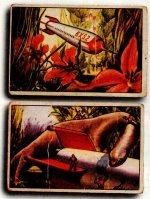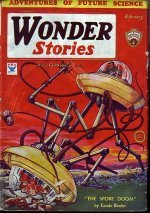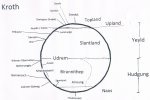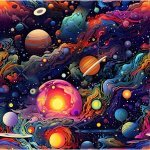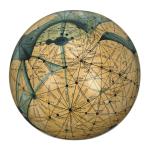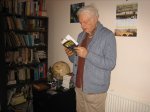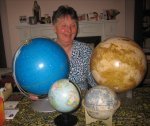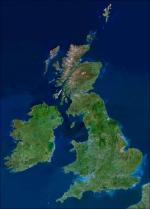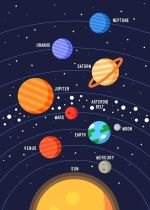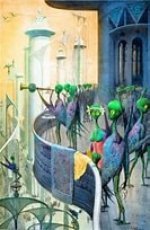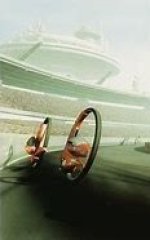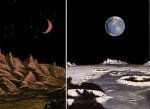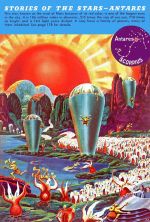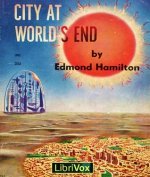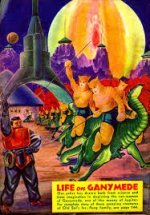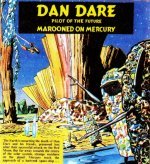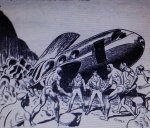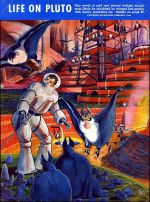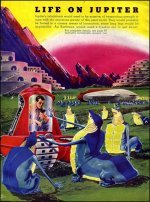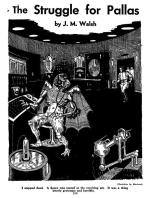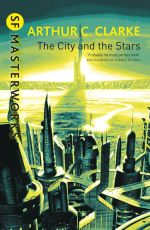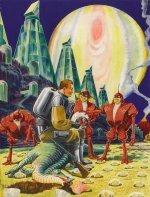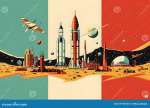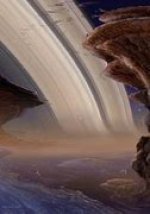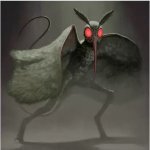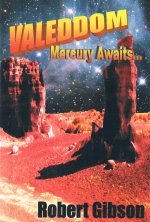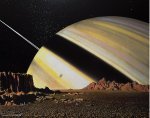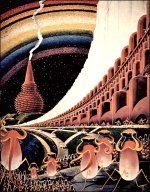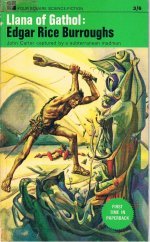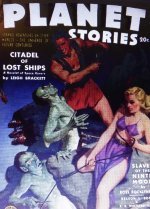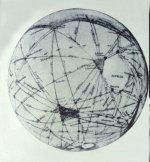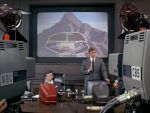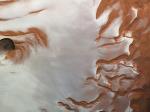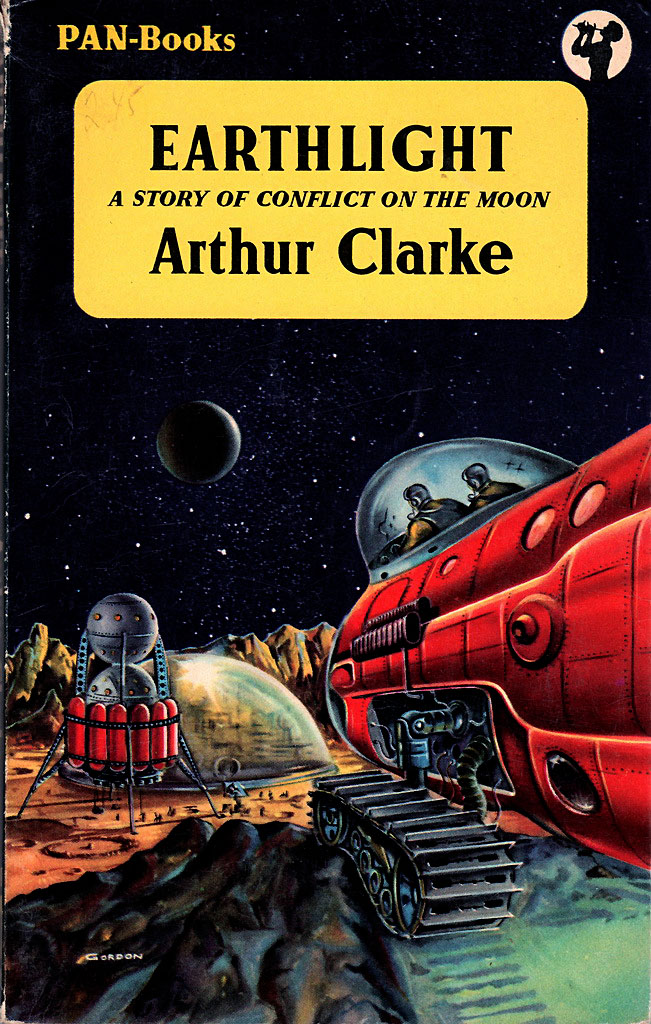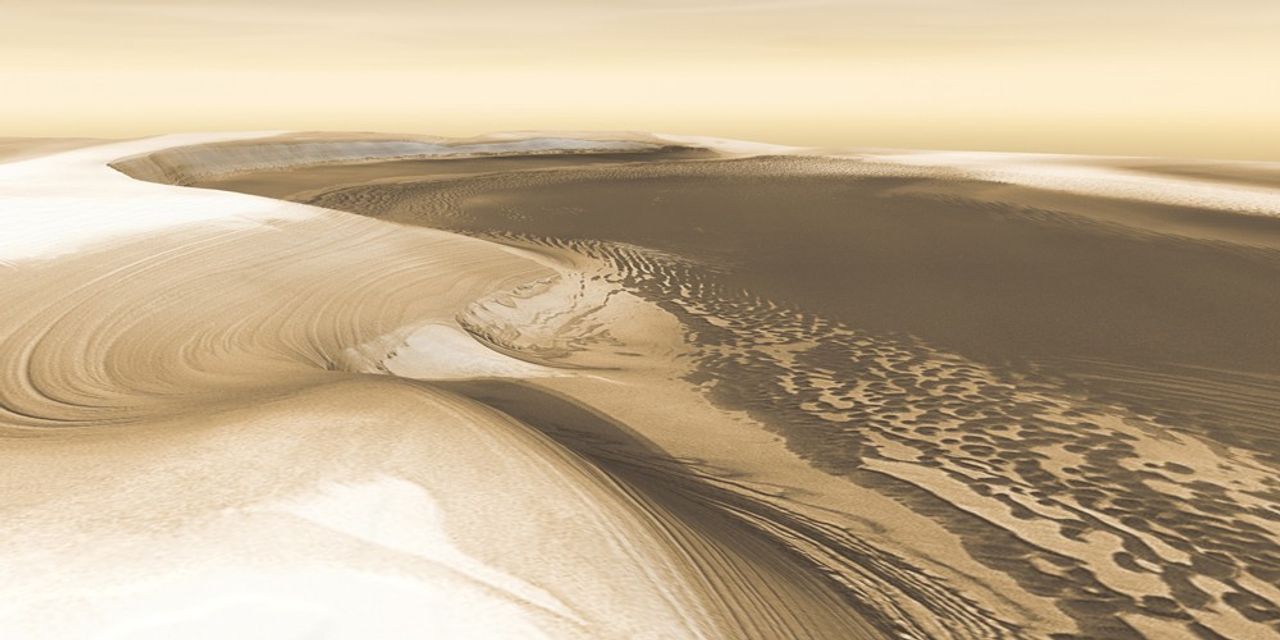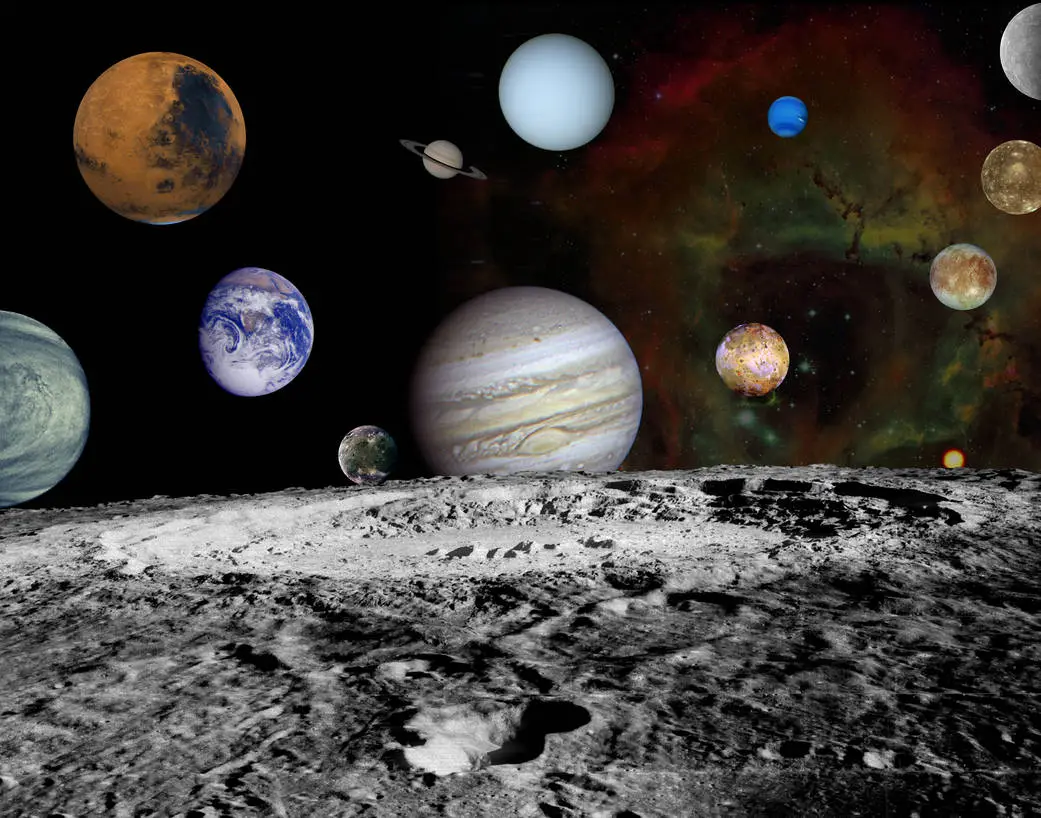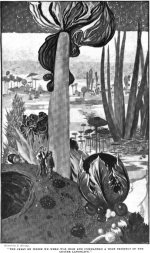- Home
- Jupiter and its moons
jupiter
[+ links to: Amalthea - Asimov on Jupiter - Asimov on Jupiter Response - Callisto - Desertion podcast - Desertion read aloud - Europa - The Galilean Satellites - Ganymede - The Great Red Spot - Io -
Jovian Inferno - Leda - Penal World - Pinnah-Birds and Genetic Engineering -
Thanator: for and against - What to see on Jupiter ]
Think of the size of it! Then, when you've thought, imagine Jupiter solid - accessible - habitable. Imagine a world that size with a surface.
For that's Old Solar System Jupiter. What a bonanza for any writer or reader! A planet over 86,000 miles in diameter; surface area well over a hundred Earths...
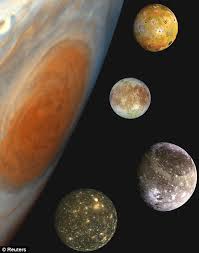
Or as we're told in Captain Future and the Space Emperor,
...a world whose fifty great jungle-clad continents and thirty vast oceans were still almost wholly unexplored.
You could have anything - you could have separately evolved biological kingdoms, comprising a multi-being, multi-empire world on which explorers wouldn't need to think about outer space because their planet could count as a universe in itself -
Not to mention the Galilean Satellites - the four planet-sized Jovian moons (elbow-room on Io, Europa, Ganymede and Callisto). And the smaller moons including Leda with its remarkable flower forest... Or, down on Jupiter itself, the particular mystery of the Great Red Spot - itself as large as a world.
how to get round the weight and the dark
Stid: The gravity's a bit uncomfortable -
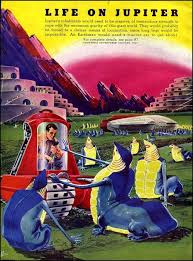 Life on Jupiter by Frank R Paul
Life on Jupiter by Frank R PaulZendexor: Only for us. Chaps like you and me would get exhausted pretty quick - no doubt about that. Swashbuckling at 2.64 gees just isn't on - even if you're furnished with the "metal body-support armor" provided by the Terran imperialists in A Conquest Of Two Worlds.
Stid: A tall story, that one. I recall that the author mentions "sunrise" and "sunset" on Jupiter. Tell me, what happened to the opaque Jovian atmosphere?
Zendexor: All right, I agree that even back in 1932, when that story was published, people surely knew (if they thought about it) that you wouldn't be likely to see sunrises and sunsets when gazing up through the Jovian cloud-bands.
Harlei: You could have the sun visible in the infrared, maybe. That's how Poul Anderson allows for sunrises and sunsets on Jupiter - his Jovians can see in the infrared. (Though even in the infrared I doubt if down there under all that atmosphere you'd be able to look up and see "the wan light of a sinking Ganymede" - as in Call Me Joe.)
Or you could have an atypical area of clear atmosphere. There's a brief tantalizing suggestion in Farmer in the Sky -

...when we passed over Jupiter's north pole... making better than thirty miles a second and we were close in, about thirty thousand miles. It was quite a sight...
It looked like a giant archery target, painted in orange and brick red and brown - except that half of it was chewed away. We saw it in half moon, of course.
There was a dark spot right at the pole. They said that was a zone of permanent clear weather and calm and that you could see clear down to the surface there. I looked but I couldn't see anything; it just looked dark.
What an idea for a story! A special, visible way through... and from the Jovian point of view, the only part of the world where you could get an idea of astronomy... cradle of Jovian culture - the north pole! And it would give a good way round the difficulty of seeing sunsets on Jupiter. Except of course you might not see the Sun anyway, I suppose, from that latitude...
Zendexor: That's right: Jupiter doesn't have an axial tilt. So, at its North Pole the Sun would be exactly on the horizon all the time... rolling round and round the horizon.
Stid: Hamilton doesn't bother to go into these questions. And forget the infrared possibilities; in his tale the sunsets are visible to Terran eyes.
Zendexor: Oh, well. So, regarding Jovian sky-visibility in Conquest of Two Worlds we'll just suspend disbelief - as we're allowed to do in the OSS, right up to that invisible limit of indulgence which is so hard to pinpoint...
But at least Hamilton bothers to pay lip-service to the gravity problem. Remember that body-support-armor I mentioned. And his natives - the stocky flipper-men - seem adequately designed for a heavy world.
Harlei: Mind you, if you want to read about really convincing home-grown Jovians, you need Poul Anderson. Take the description of Norlak and Theor in Three Worlds to Conquer:
A man seeing those two Jovians would doubtless have thought, Centaur. But that was too crude. Theor's hairless red body, stub-tailed and tiger-striped, did stand upon four stout legs; but each foot had three prehensile toes. His long arms, four-fingered hands, and blocky torso might be considered anthropoid, if one overlooked innumerable details. But his round head lacked external ears and bore a rooster-like comb, fifty inches above the ground. The mouth sat close below the great eyes, and was only for eating and drinking. Speech came by vibrating muscle tissue in a pouch under the jaws.
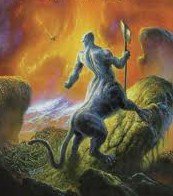 Joe
JoeHe had no nose or lungs in any terrestrial sense. Half a dozen slits on either side of his thorax, with lips to close them at need, let hydrogen diffuse inward, where his metabolism employed it to obtain energy by reducing organic compounds whose ultimate source was vegetation. The methane and ammonia given off by this process came out through abdominal vents. At Jovian air pressure, the system was efficient enough to support a large, active animal.
Zendexor: We're into serious stuff now. Compared to that description, Hamilton's "flipper-men" aren't much. But - they're enough. For purposes of their story, they're enough. The most rudimentary concession to realism is all you need, when your main point lies elsewhere. Give due moral credit to A Conquest of Two Worlds: it is a vivid anti-imperialist statement.
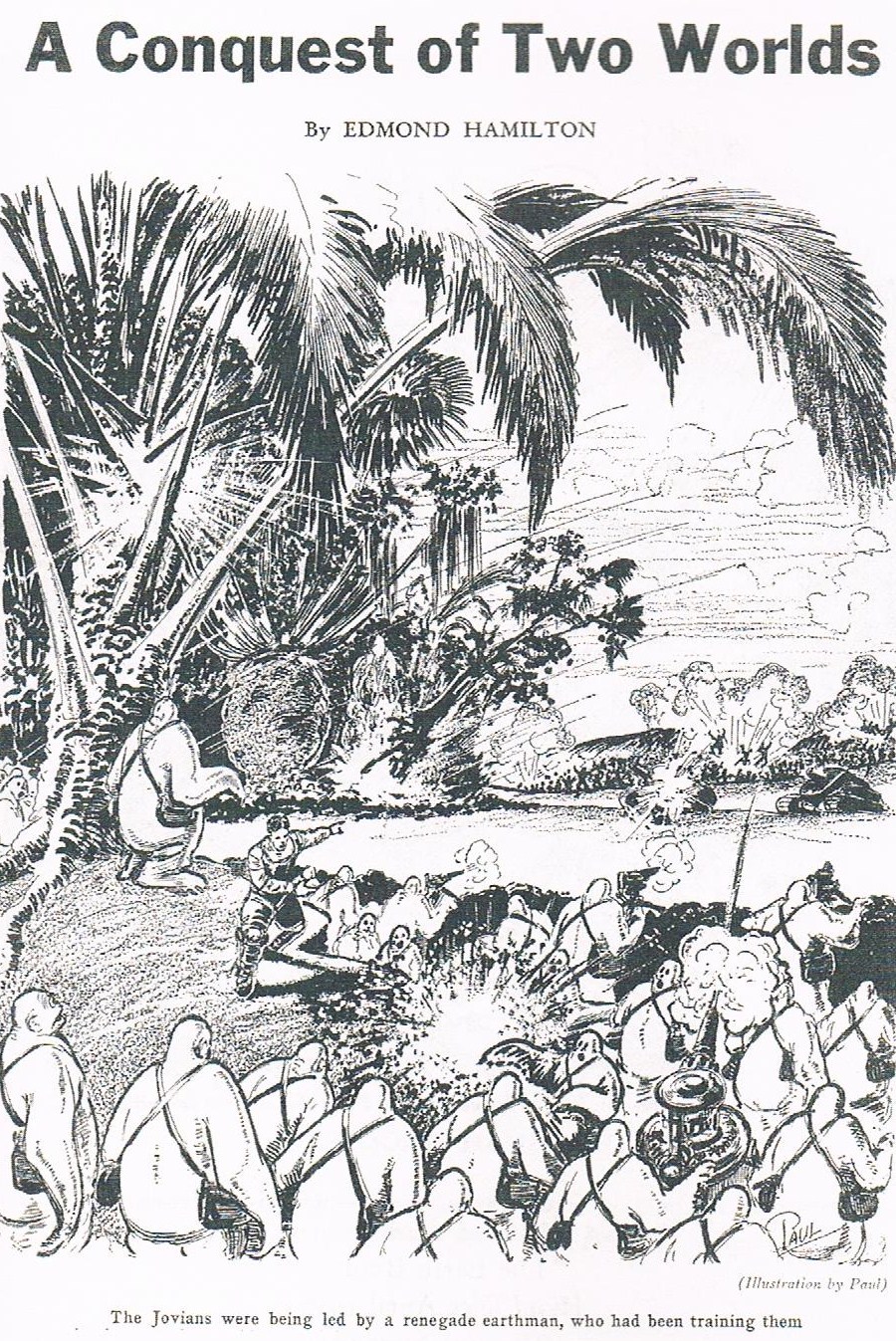
Stid: True enough. Hamilton's childlike, innocent Jovians engage our sympathy as, led by the renegade Earthman, Halkett, they fight for their world.
It was the retreat of a race - the weary hosts of the Jovians ever backing northward through the steamy fern forests that had been theirs for untold time, throwing up new dirtworks and digging new trenches always at Halkett's command, using every sort of ambush device Halkett could think of to hold back the earthmen. The fern forests resounded with the roar of atom-blasts and crash of atom-bombs, strange things flopping this way and that in the green depths to escape the battle, the Jovians all round the planet fighting bitterly now for existence.
Zendexor: I agree, it's a great story - Hamilton's 1932 debut as a major writer, in fact. No sense in knocking it on scientific grounds, as even non-OSS fans will probably admit. And besides, you'd be expecting too much of sf in general, if you were to demand that all writers must know enough science to give what Poul Anderson gives. If you became as demanding as that, you'd stop others from giving us what they can give. Result: no more C S Lewis; no more Brackett, Bradbury, Burroughs... all greats who get by with paying mere lip-service to science.
And on this page, lip-service is our key to Jupiter! Get the vital snippets right, arrange a minimal sprinkling of perfunctory excuses, and it'll be all you need to make the story work, so long as other aspects of the writing make up for the skimpy realism.
Stid: Are you being a touch cynical, Zendexor?
Zendexor: Not a bit. Multitudes of great OSS stories depend upon the convention that you need only make a perfunctory bow to science, to class them as science fiction.
And sometimes you may think that bow is too slight - that scientifically the plot is a joke. Never mind - if it works! Mighty Jupiter makes his own rules of literary gravitation. The thing to do is to sound out the limits of what is literarily possible.
Now then, Stid - about that opaque Jovian atmosphere: you'll be pleased to hear that Edgar Rice Burroughs, of all people, scores points for lip-service realism here.
Stid: You mean to tell me that old ERB gets it righter than Hamilton?!
Zendexor: In this case, yes. The captive John Carter narrates his descent through the atmospheric envelope in Skeleton Men of Jupiter:
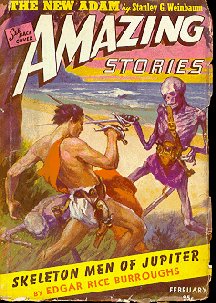
I was all eagerness to see the surface of Jupiter; and extremely impatient of the time that it took the ship to traverse the envelope, in which we could see absolutely nothing.
At last we broke through, and what a sight was revealed to my astonished eyes! A great world lay below me, illuminated by a weird red light which seemed to emanate from the inner surface of the cloud envelope, shedding a rosy glow over mountain, hill, dale, plain, and ocean. At first I could in no way account for this all-pervading illumination; but presently, my eyes roving over the magnificent panorama lying below me, I saw in the distance an enormous volcano, from which giant flames billowed up thousands of feet into the air. As I was to learn later, the crater of this giant was a full hundred miles in diameter and along the planet's equator there stretched a chain of these Gargantuan torches for some thirty thousand miles, while others were dotted over the entire surface of the globe, giving both light and heat to a world that would have been dark and cold without them.
That takes care of the light supply, and as for the gravitation, it's more than offset (in this story) by the centrifugal force of the planet's rapid rotation.
A more serious way of getting round the gravity problem is to have your hero genetically strengthened, as in Thunder World.
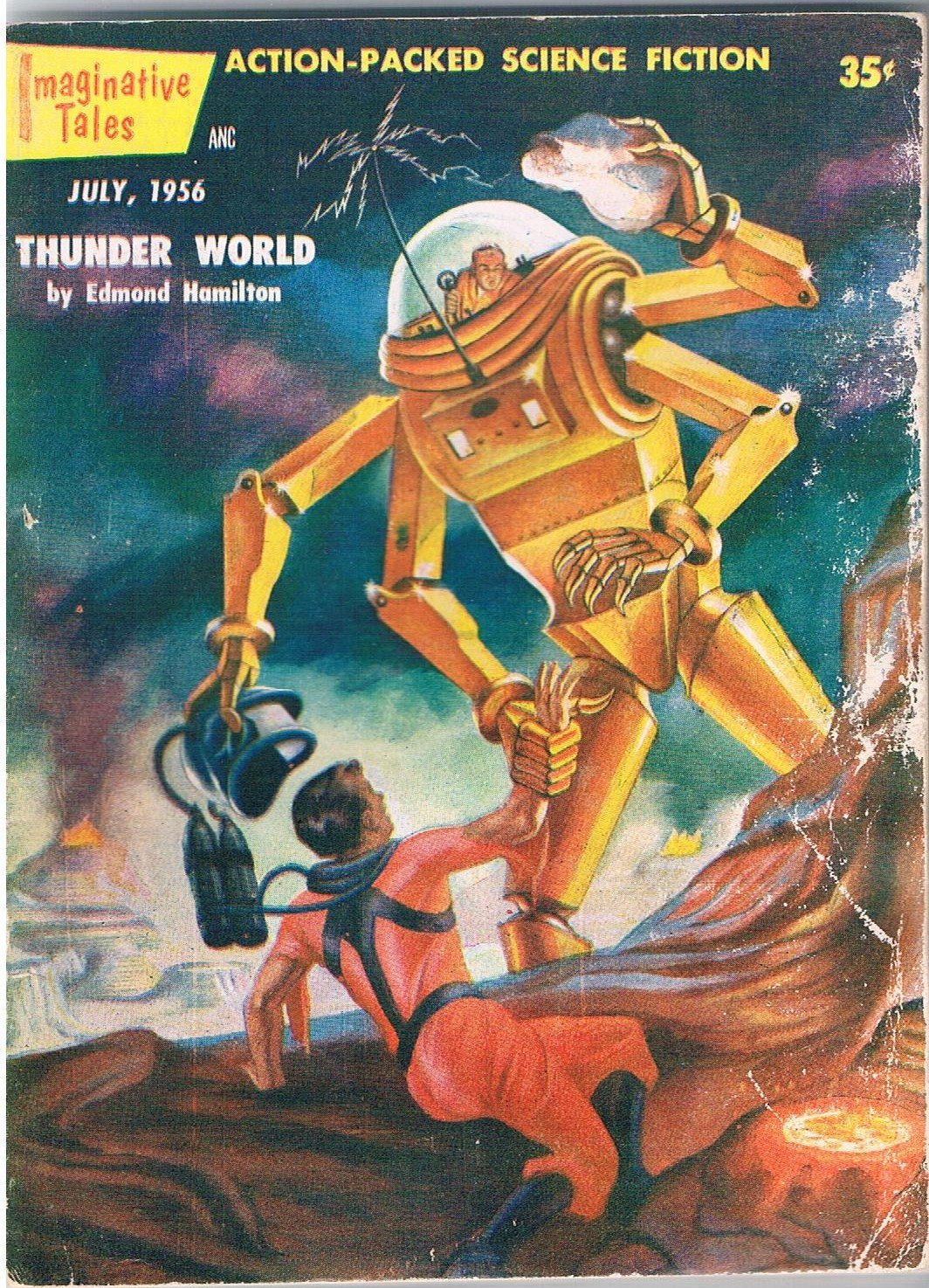
That is how Farrel Baird is able to
...stride out into a hellish chaos of sound and light and mist. The mind-shattering explosions of thunder from far up in the cloud-envelope were accompanied by ghastly flares and rivers of lightning that each time illuminated the misty scene about him.
Stid: This pays more lip-service to the violence of the real Jupiter, but of course it's still nothing more than lip-service - no amount of genetic engineering would get men down onto the Jupiter described in Bridge, for instance.
Here's the engineer, Helmuth, nightmaring about the only occasion on which men ever descended beneath the Jovian cloud-tops:

Instantly he was in the grip of the dream.
It started, as always, with commonplaces, almost realistic enough to be a documentary filmstrip - except for the appalling sense of pressure and the distorted emotional significance with which the least word, the smallest movement was invested.
It was the sinking of the first caisson of the Bridge. The actual event had been bad enough. The job demanded enough exactness of placement to require that manned ships enter Jupiter's atmosphere itself: a squadron of twenty of the most powerful ships ever built, with the five-million-ton asteroid, trimmed and shaped in space, slung beneath them in an immense cat's cradle.
Four times that squadron had disappeared beneath the clouds; four times the tense voices of pilots and engineers had muttered in Helmuth's ears; four times there were shouts and futile orders and the snapping of cables and someone screaming endlessly against the eternal howl of the Jovian sky.
It had cost, altogether, nine ships and 231 men, to get one of five laboriously shaped asteroids planted in the shifting slush that was Jupiter's surface...
Zendexor: I admit that compared with this, even Thunder World sounds tame; but in return you must admit that Thunder World at lease does give us a scene quite different from the fertile Jupiter described by the same author twenty-four years earlier, in 1932. The later story gives us no fern jungles, no gentle flippered natives. Instead:
The towering rocket stood upon a plateau of dark rock. Far to the west, there rose cluttered ranges of icy peaks. Toward the east, he could glimpse where the plateau dropped off in a steep slope, and away in that direction the mist was lit by a steady, infernal orange-red glow.
Farrel Baird is later told what had been done to him, to make him able to stand it.
"Your body is different in its tissues than other mens'. The connective tissues of the cells are semi-solid matrices, to use the physiological term. It means that your body-walls and sheathings are as tough as cartilage..."
Yet another way of doing it is to have a native hero. That, as we have seen, is convincingly achieved in Three Worlds to Conquer.
Or - a compromise between strengthened Earthmen and naturally-evolved natives - you can have Earth people assume native forms, as in Call Me Joe and Desertion.
Good enough so far? You know what, I'm getting tired of the gravity issue. Can we move on from this whole Realism-versus-Art thing? I'm itching to put an end to all quibbles and to explore Jupiter! Otherwise I'll feel like John Carter when he was imprisoned by the skeletal Morgors:
...And here was I, an adventurer who had explored two worlds, cooped up in a subterranean cell upon the most amazing and wonderful planet of our entire solar system. It was maddening.
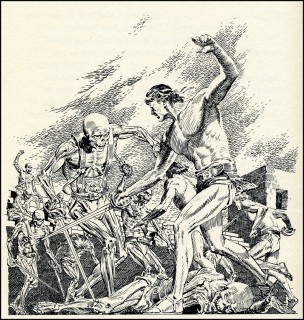
Harlei: Watch out, Stid. I can hear Zendexor's teeth grind.
Stid: No need; I accept what he says, and won't try to coop him up in the dungeon of realism. Besides, I know the score... Science fantasy has its own rules, and never gets out of date. That takes care of Skeleton Men of Jupiter and the like.
What interests me is science fiction.
Zendexor: Then you should like Three Worlds to Conquer. The realism is breathtaking; the explanations are a joy to read; in short, the science in the yarn is outstanding. Er, except, of course -
Stid: Yeah, except for the main point - that we're shown Jupiter with a solid surface.
how to provide firm ground
Harlei: Come on, Stid, you admitted science fantasy has its own rules -
Zendexor: But he means, I think, that Poul Anderson is supposed to know better.
Stid: Yes, I do mean that. Say what you like, Zendexor, I just can't help being curious to know what excuses an author like Anderson, highly qualified in science, can put forward for solidifying a gas giant planet that's largely composed of hydrogen and helium.
Zendexor: Very well - in this case I admit to a similar curiosity. In scientific knowledge and understanding, Anderson does rank among the best "hard" science fiction authors, despite his romantic soul, so I ask myself: what was going through his head, when he gave Jupiter a solid surface?
I have found one clue.
It's in his novella Call Me Joe.
...he regarded the boulders strewn wind-blasted grey over the tough mossy vegetation of the slope. They were not much like Earth rocks, nor was the soil beneath his feet like terrestrial humus.
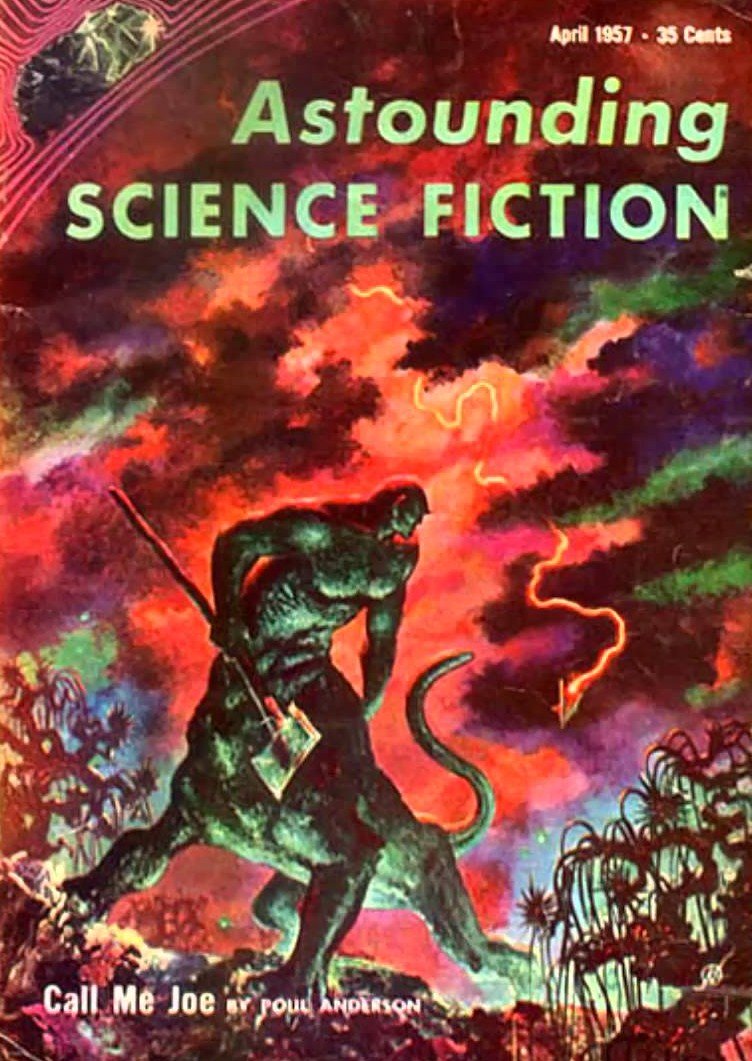
For a moment Anglesey speculated on the origin of the silicates, aluminates and other stony compounds. Theoretically all such materials should be inaccessibly locked in the Jovian core, down where the pressure got vast enough for atoms to buckle and collapse. Above the core should lie thousands of miles of allotropic ice, and then the metallic-hydrogen layer. There should not be complex minerals this far up, but there were.
Well, possibly Jupiter had formed according to theory, but had thereafter sucked up enough cosmic dust, meteors, gases and vapours down its great throat of gravitation to form a crust several miles thick....
Could it be, then, that Jupiter was thought by some scientists to have a solid surface, back in 1957, or in 1964 when Three Worlds to Conquer was published?
Stid: If that's so, I'm surprised. I find it hard to believe.
Zendexor: Well, let's see some more of the structure of Anderson's Jupiter.
I quote from the passage in which the centaur-like Jovian hero of Three Worlds to Conquer. comes across a volcano or "fire-pot":
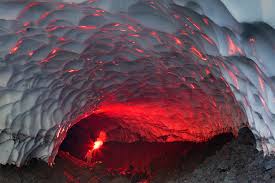
When he looked into that yard-wide hole, his eyes were dazzled. The roaring down there was as loud as the thunder around him. His gills cramped shut in reflexive protest against the fumes...
The moltenness which raged within was water... But Theor's kind of life had not evolved to endure such conditions.
Liquid water to a Jovian is what molten lava would be for us. (The author isn't shy of weaving his own comments into the narrative, and it is just as well he does - his "lectures" enhance the tale.)
The metallic core of Jupiter is wrapped in thousands of miles of solid hydrogen. Above this is a shell of ice, less vast but quite adequate to maintain pressures that collapse ordinary molecular structures. Somewhere in those depths, an equilibrium had been broken. The pressure in a certain volume dropped below a critical value. A titanic mass of ice changed to a less dense crystalline phase in an explosion comparable to that of a large thermonuclear bomb. Liquefied by the released energy, water spurted through the riven planetary surface. It could not vaporize, the atmosphere weighed too heavily on it. Cooling and congealing, it built up a cone which rapidly grew to be a mountain. The flow might continue for centuries before a new balance was struck and the volcano became extinct.
Harlei: Wow - the more I read that book, the more I feel that Anderson almost makes it genuinely believable, this solid-Jovian-surface theme.
Stid: But if it turned out to be true, we'd have to wipe it off our website! Our business is with OSS tradition, not truth. Isn't that true, Zendexor?
Zendexor: Yes, but don't worry, it's just a dream, just a great author weaving his magic. Of course I wish it were true... but if there were the slightest chance of firm ground on Jupiter I'm sure we'd have heard of it from eager would-be exobiologists like Carl Sagan.
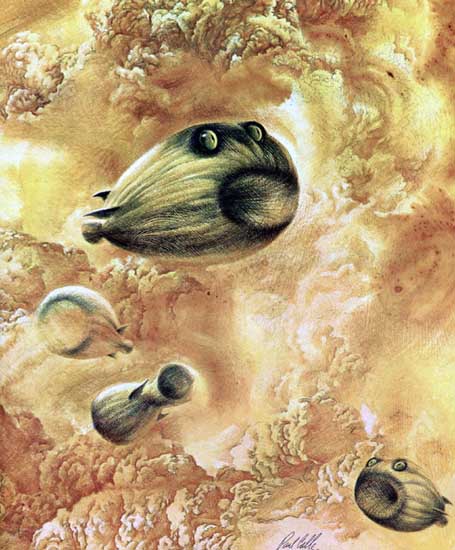 by David Darling
by David DarlingStid: I seem to recall that Sagan was happy to speculate about ammonia-blooded balloony creatures floating around in the Jovian atmosphere.
Zendexor: And that still might turn out to be true. So stories about aerial Jovian life aren't to be classed as out-dated or retro. That's why I'm omitting discussion of A Meeting With Medusa. Superb tale though it is, it's not sufficiently "Old Solar System" for this site.
Mind you, Three Worlds to Conquer also emphasizes the importance of aerial life.
The Jovian hero Theor, a fugitive in the mountains, high above his usual haunts, encounters tiny floating flakes of life, and whale-sized floaters that feed on them:
A life zone indeed, he thought shakenly. Airborne, inhabiting these upper regions - and we never knew. But we belong to the dark depths.
Theor is in radio communication with an Earthman stationed on Satellite Five, and now recalls that the man had told him
that spectroscopy indicated that Jupiter had a dense microbial population in the high atmosphere. The discovery had not seemed important to Theor. What was the significance, if organisms too small to see floated above the clouds? But if they supported larger species, which supported larger ones yet... why, his whole world was inside a shell of life!
The author comments on Theor's thoughts, and then adds:
In fact, it seems probable that Jovian life originated at great altitudes, and that it remains more abundant there than on land and sea. Though the planetwide ecology has yet to be worked out, one may theorize that the surface population is dependent on what drifts down from above...
Harlei: So, from the Sagan view as a starting point, life then encroaches downwards, till it covers the ground... in which case we can hope to end up with Captain Future's jungly Jupiter! Or the lovely description in Spacehounds of IPC of the Jovian jungle
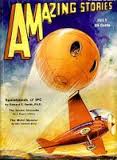
loathsomely palpitant with an unspeakable exuberance of foul and repellent vigour.
Zendexor: Anderson's version is less juicy than Doc Smith's.
As he looked more carefully at his surroundings, Theor felt a return of dismay.
He stood on the edge of forest growth. The trees were mostly yorwar, thick-boled, with hollow upward-floating limbs and the characteristic Jovian leafage which would have reminded a man of lung tissue. Their "photosynthesis", building complex molecules out of methane and ammonia, releasing hydrogen in the process, depended on synchrotron radiation as well as lightning and the feeble sun, and so required a maximization of internal surface. The crowns rarely lifted more than fifteen feet above the roots. But they stretched endlessly on, farther than he could see...
Harlei: Endless, endless... That sums it up. The possibilities of Jupiter. Who's exploring them at the moment?
Zendexor: That's what I'd like to know. Calling all retro-Golden-Age writers: we need some ten-volume Jovian epics, please. Preferably with some advanced Jovians. The ones in Three Worlds to Conquer are extremely well drawn but not far removed from barbarism...
Stid: You forget that Dominic Flandry, in another Anderson tale, Hunters of the Sky Cave, actually flew over a Jovian city.
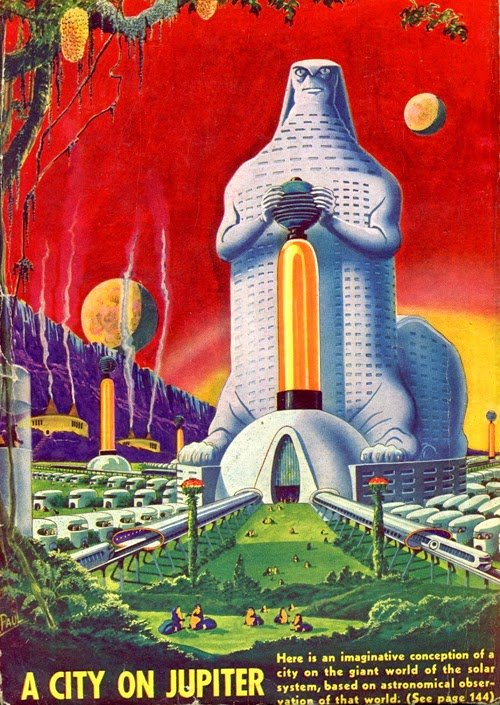
Zendexor: Oh yes, good, here's an excuse to show the Frank R Paul picture of a Jovian city -
Stid: Nothing to do with the one in Anderson's story.
Zendexor: How do you know what's to do with what, in the mind of a Jovian?
Stid: Very well. Let me quote Flandry's ship's approach (the scene outside is visible to Flandry only because of the "step-up screens", presumably working in the infrared):
They circled the night side, still descending, and Flandry saw a methane ocean, beating waves flattened by pressure and gravity against a cliff of black allotropic ice, which crumbled and was lifted again even as he watched. He saw an endless plain where things half trees and half animals - except that they were neither, in any Terrestrial sense - lashed snaky fronds after ribbon-shaped flyers a hundred meters in length. He saw bubbles stream past on a red wind, and they were lovely in their myriad colors and they sang in thin crystal voices which somehow penetrated the ship. But they couldn't be true bubbles at this pressure. Could they?
A city came into view, just beyond the dawn line. If it was a city. It was, at least, a unified structure of immense extent, intricate with grottos and arabesques, built low throughout but somehow graceful and gracious. On Flandry's screen its color was polished blue. Here and there sparks and threads of white energy would briefly flash. They hurt his eyes. There were many Ymirites about, flying on their own wings or riding in shell-shaped power gliders. You wouldn't think of Jupiter as a planet where anything could fly, until you remembered the air density; then you realized it was more a case of swimming...
Zendexor: All right, I'll grant that it was a city, though Flandry himself didn't seem sure. As good as a city, anyhow. Perhaps the whole thing was Governor Thua's residence!
Anyhow the point is that the inhabitants are Jovians only in the sense that they live on Jupiter. They don't come from Jupiter but from another giant planet, called Ymir, somewhere in interstellar space. The Terran Empire has traded the gas giant worlds we humans can't use, for the Ymirites' small oxygen Earth-like worlds that they can't use, with the result that they have occupied Jupiter. That's the scenario in Hunters of the Sky Cave and the other Flandry novels.
So what I've said before still goes: we want an advanced race of native Jovians, please.
jovian powers
Harlei: Well, you've got the hexans in Spacehounds of IPC.
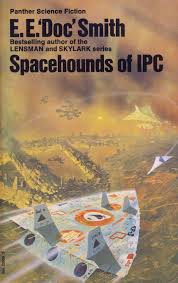 boring cover - pity Foss couldn't draw Vorkuls
boring cover - pity Foss couldn't draw VorkulsZendexor: True, I had momentarily forgotten about them. Since they're only of any use as baddies, I'll rephrase my demand: we want an advanced race of non-genocidal Jovians, please.
Stid: Maybe that's asking rather a lot, Zendexor! I get the impression that there must be something in the fictitious Jovian soil that breeds intolerance of smaller planets. If you add together the murderous space-faring Hexans from Spacehounds of IPC, plus ERB's skeleton men, plus the equally nasty though planet-bound Jovians of Not Final! and Victory Unintentional -
Zendexor: Ah yes, that last pair of stories, they do indeed add to our roster of Jovian menaces. (We deal with Not Final! and Victory Unintentional in our page Asimov on Jupiter.) So, how about it, Harlei? Any chance of a native Jovian culture that's both advanced and reasonable?
Harlei: Not sure if this is quite what you want, but let me offer you the hexans' opponents, from the opposite hemisphere of Jupiter: the Vorkuls. They're not genocidal - but they are extremely self-absorbed! They're not interested in any contact with Earth.
Vorkulia, the city of the Vorkuls, was an immense seven-pointed star. At its centre, directly upon the south pole of Jupiter, rose a tremendous shaft - its cross section likewise a tapering seven-pointed star - which housed the directing intelligences of the nation. Radiating from the seven cardinal points of the building were short lanes leading to star-shaped open plots, from which in turn branched out ways to other stellate areas...
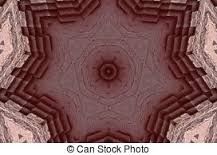
Colour ran riot; masses varied from immense blocks of awe inspiring grandeur to delicate tracery of sheerest gossamer; lights flamed and flared in wide bands, and in narrow, flashing pencils - but in all, through all, over all, and dominating all was the Seven-pointed Star.
...In a lower compartment of one of these enormous heptagons Vortel Kromodeor, First Projection Officer, rested before a gigantic and complex instrument board. He was at ease - his huge wings folded, his sinuous length coiled comfortably in slack loops about two horizontal bars. But at least one enormous, extensible eye was always pointed towards the board, always was at least one nimble and batlike ear cocked attentively in the direction of the signal panel...
Well, the Vorkuls, in alliance with Earth humans, defeat the hexans. At one point, some humans save Kromodeor's life, yet the Vorkul shows no gratitude. He merely zooms off without a word of thanks, anxious to get back to his own kind, his own culture, which is all he's interested in.
This behaviour causes some indignation among the Earthmen, yet one of them wisely comments:
"...But is it absolutely necessary that all intelligent beings should possess such an emotion as gratitude? Such a being without it does seem funny to us, but I can't see that its lack necessarily implies anything particularly important...
"They are, of course, very highly developed and extremely intelligent; but it should not be surprising that intelligence should manifest itself in ways quite baffling to us human beings, whose minds work so differently..."
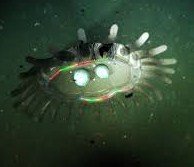
And that reminds me: you say you aren't keen on reading about the purely genocidal Jovians - the "hexans". But there might, you know, be a reason for their behaviour, which might make them seem less one-dimensionally bad.
The reason might be, simply, their unimaginable differentness. They might be so unlike other beings in nature as to be unable to accept the very idea of non-Jovian life; a failure of imagination which likewise applies to the psychotic Jovians whom we discuss in Asimov on Jupiter.
Stid: Now then, regarding this great "unimagineable differentness", can one have it both ways? Make the Jovians contactable enough to be interesting, but different enough to seem real?
interrogating captives in the terran-jovian war
Zendexor: Interesting but strikingly alien - well, how about some giant Jovian flatworms? I'm now thinking of a particular story which takes our literary quest one stage further...
Stid: With civilized, technically advanced, non-psychotic Jovians, who are reasonable enough to satisfy you, Zendexor?
Zendexor: Despite their lack of discernible limbs and sense organs they're certainly advanced, so much so that they possess a space-faring empire which extends out to Saturn. They're fighting a war with Earth, but they aren't all militaristic war-mongers; there is a peace faction among them, including The Deserter himself.
Stid: Well then, you've got what you want.
Zendexor: But it's only a very short story. Nevertheless it packs a punch, and shows what can be done in this line...
Let's look at what happens when Major-and-Doctor Igor Mardin is ordered by a ridiculous Terran brasshat to ask a Jovian captive for his "name, rank and serial number".
...He addressed himself to the immense blanket of quiescent living matter below him... On the basis of their examination of dead Jovians, some scientists maintained that the creatures were really vertebrates, except that they had nine separate brains and spinal columns; other biologists insisted that the "brains" were merely the kind of ganglia to be found in various kinds of invertebrates and that thinking took place on the delicately convoluted surface of their bodies. And no one had ever found anything vaguely resembling a mouth or eyes, not to mention appendages that could be used in locomotion.

The human interrogator projects a thought at the captive, asking it to identify itself.
The reply is a memory:
Abruptly, he found himself on the bottom of a noisy sea of liquid ammonia, clustered with dozens of other newborn around the neuter "mother". Someone flaked off the cluster and darted away; he followed. The two of them met in the appointed place of crystallization and joined into one individual. The pride he felt in the increase of self was worth every bit of effort.
Then he was humping along a painful surface. He was much larger now - and increased in self many times over. The Council of Unborn asked him for his choice. He chose to become a male. He was directed to a new fraternity.
Later, there was a mating with tiny silent females and enormous, highly active neuters. He was given many presents. Much later, there was a songfest in a dripping cavern that was interrupted by a battle scene with rebellious slave on one of Saturn's moons...
Mardin slowly assimilated the information in terms of human symbology.
"Here it is, sir," he said at last hesitantly into the mouthpiece. "They don't have any actual equivalents in this area, but you might call him Ho-Par XV, originally of the Titan garrison and sometime adjutant to the commanders of Ganymede." Mardin paused a moment before going on. "He'd like it on the record that he's been invited to reproduce five times - and twice in public."
Stid: Quite normal for Terran TV, in other words.
Zendexor: I see your point, but bear in mind that this story appeared back in 1953, when your reaction was supposed to be, "Gosh, what alien beings these are", instead of - otherwise.
Stid: All right, I'll react in the spirit of the Fifties and say, wow, how weird. We must be moving beyond the OSS genre into alien realism, into what life on an utterly strange world like Jupiter might really be like.
Except, that is, for that "surface" at the bottom of the ammonia sea.
Zendexor: Right. The real Jupiter might turn up just about anything - except a solid surface. Apart from that, we might, as you suggest, have strayed over the literary border... for despite our cracks at Terran TV, the author of The Deserter really does have a good go at giving us a possibly real Jovian. He doesn't skimp on the alienage. The protagonist, Mardin, had himself previously spent some time as a captive of the Jovians. That was where he had learned to talk to them, mind-to-mind. It wasn't easy:
...Superficially, it might seem that a mechanism for sharing thoughts was the ideal answer to communication between races as dissimilar as the Jovian and the Terrestrial. In practice, Mardin knew from long months of squeezing his imagination under orders in Three Watertanks, a telepathy machine merely gave you a communication potential. An individual thinks in pictures and symbols based on his life experiences - if two individuals have no life experiences in common, all they can share is confusion. It had taken extended periods of desperate effort before Mardin and his Jovian captor had established that what passed for the digestive process among humans was a combination of breathing and strenuous physical exercise to a creature born on Jupiter, that the concept of taking a bath could be equated with a Jovian activity so shameful and so overlaid with pain that Mardin's questioner had been unable to visit him for five weeks after the subject came up and thenceforth treated him with the reserve one might maintain toward an intelligent blob of fecal matter.
But mutually accepted symbols eventually had been established...
Poul Anderson, "Call Me Joe" (Astounding Science Fiction, April 1957); Hunters of the Sky Cave (1959); Three Worlds to Conquer (1964); James Blish, "Bridge" (Astounding Science Fiction, February 1952); Edgar Rice Burroughs, "Skeleton Men of Jupiter" (Amazing Stories, February 1943); Arthur C Clarke, "A Meeting With Medusa" (1971); Edmond Hamilton, "A Conquest of Two Worlds" (Wonder Stories, February 1932); Captain Future and the Space Emperor (1939); "Thunder World" (Imaginative Tales, July 1956); Robert A Heinlein, Farmer in the Sky (1950); Clifford D Simak, "Desertion" (Astounding Science Fiction, November 1944); E E Smith, Spacehounds of IPC (1931; 1947); William Tenn, "The Deserter" (Star Science Fiction Stories #1, 1953), included in Bug-Eyed Monsters (1972) ed. Anthony Cheetham.
For ideas for stories about ancient Jupiter see the OSS Diary for 30th and 28th October 2016.
Sports fans note: Jupiter was the winner of the first Interplanetary Knock-Out, September 2016.
For The Incandescent Ones by Fred and Geoffrey Hoyle see the OSS Diary for 20th December 2016. See also Approaching a vast presence on Jupiter.
For a dawn scene on Poul Anderson's Jupiter see the OSS Diary for 22nd February 2017. The rainstorm is discussed in The Author's Voice-Over.
For a waterfall on Jupiter see the OSS Diary, 18th March 2017, regarding John Jacob Astor's A Journey in Other Worlds.
For the successful inconsistency of Buroughs' Jupiter see "The Needle Swings on Sassoom", in the OSS Diary for 19th March 2017. And regarding the same story see Searching for further adventures on Sassoom.
For the distribution of human and hexan Jovian telemorphs, see the OSS Diary, 30th March 2017.
See Permissible Invention of Moons for Murray Leinster's invented Jovian moon Calypso.
For comments on Carl Sagan's comments on Christiaan Huygens' supposed presuppositions of Jovian life, see the Diary entry, Hemp on Jupiter...
See also a plea to save Jupiter from Dyson-sphere developers.
For a super-unrealistic rendition of a Jovian landscape see Naive Jovian View.
For a slushy Jovian surface see Borderline settings.
Sneaking down to Jupiter discusses an uncharacteristic mention by Arthur C Clarke.
For the question of "Jovian volcanoes" see A ghostly nudge from Jupiter.
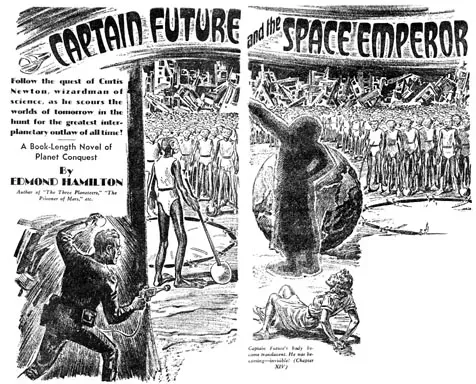 Captain Future's first Jovian adventure
Captain Future's first Jovian adventure